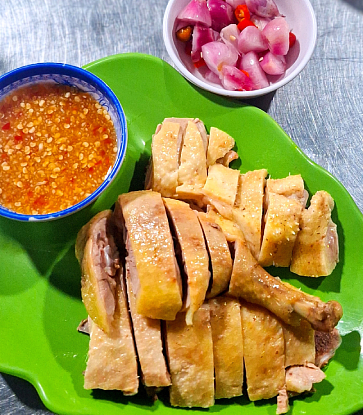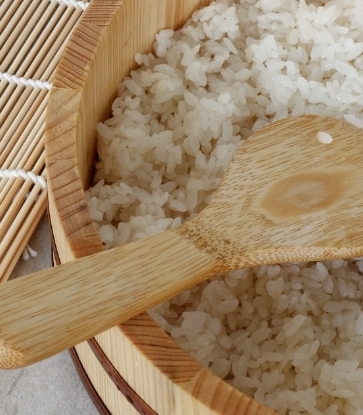All throughout history, foods like oysters, berries and dark chocolate have been purported to have a powerful effect on boosting potency, libido and sex drive. Aphrodisiacs are named after Aphrodite, the ancient Greek goddess of love and beauty. But whether they are old wives’ tales born of centuries of lore or backed up by scientific evidence, every culture and culinary tradition has its own list of aphrodisiacs.
Six chefs from MICHELIN-recommended establishments in the region tell us about the dishes and ingredients in their cuisines that might just get you in the mood for love.

Spices And Curries
The Song of India's Chicken Suneri
One MICHELIN Star, MICHELIN Guide Singapore 2019
The Indian kitchen is known for vegetarian dishes and a larder of herbs that are said to boost your libido, according to Manjunath Mural, Director of Cuisine at The Song of India in Singapore. Some of these include garlic, saffron, cinnamon, milk, almond, pistachio, cumin, pumpkin seeds, figs, star anise, pomegranate seeds, ginger, chili peppers and honey.
The sensuality of these foods have deep roots in Indian tradition and continue to be a mainstay in contemporary culture. "On the wedding night, or Suhag Raat, the bride is expected to give the groom a glass of warm milk infused with spices such as almond and saffron. It is believed to keep the sexual stamina high all night. This tradition is depicted a lot in Bollywood films,” Mural shared.
The chef also added that the aphrodisiac foods of Indian cuisine date back to ancient times when kings were fond of rich curries that brim with aphrodisiacs such as almond, pumpkin seeds, cashew nuts, garlic and garam masala — ground powder made of nutmeg, cinnamon, star anise, and bay leaves — which they believed not only kept them strong, but also helped enhance their romantic lives.
Modern day diners can get their curry fix at The Song Of India, where the Chicken Suneri is smothered in a rich curry sauce redolent of almond and fennel. Order a glass of spice-infused warm milk to spice things up.

Foie Gras And Oysters
Duddell’s Foie Gras And Braised Abalone In Supreme Oyster Sauce
One MICHELIN Star, MICHELIN Guide Hong Kong Macau 2020
“In Cantonese culture, we believe in eating foods in the likeliness of the part of the body you are trying to nourish," said Li Man-Lung of Duddell’s in Hong Kong. Traditionally, aphrodisiac foods for the Cantonese in China and Hong Kong have included snakes, chicken testes, and bull penis. But Chinese cuisine is now a lot more westernised with oysters, foie gras, caviar, and chocolate, Li added.
Last year, the chef served foie gras slow-cooked in supreme broth for the restaurant's festive Valentine's Day menu. The soup was made by simmering lean chicken and pork for hours. The foie gras was slow-cooked to preserve its smooth texture and taste, then braised with sake to cut its greasiness while enhancing its sweetness.
This year, Li will present another take on foie gras for the occasion. The braised foie gras will be pan-seared until it gains a nice colour and aroma, before being served with a quintessentially Cantonese abalone and oyster sauce.

Oysters And Wine
Elements' Kaviari Kristal Caviar With Special Oyster
One MICHELIN Star, MICHELIN Guide Thailand 2020
Chef de cuisine Hans Zahner of Elements in Bangkok is well-known for combining precise French culinary technique with Japanese refinement. He sees oysters as a lover’s dish because of its nutrients. The molluscs are rich in iron, manganese, Vitamin C and B12, as well as a good amount of protein.
“Although it’s still unclear whether oysters were aphrodisiac for ancient Greeks or Romans, the delicious sea creatures have always been considered a luxury," said the chef, pointing out the numerous historical references to its libido-boosting prowess. Emperor Clodius Albinus was so fond of it that he consumed 400 pieces at once. Also, Pliny the Elder, the famed Roman naturalist, described how oysters served in extravagant feasts were covered in snow to preserve its freshness, according to Zahner. Oysters also appeared in Renaissance medical records as sexual stimulants. Some say that Casanova shared a plate of fifty raw oysters with his ‘guests’ to boost the power of lust and desire.
Oysters are one of the well-known dishes from Elements’ signature menus. The French chef who hails from the country of love recommends ordering oysters from Brittany or Normandy, eaten raw or slightly cooked. Pair them with red or white Burgundy wine to light the night on fire.

Chillies And Local Thai Herbs And Spices
Thai Niyom's Kaeng Pa
Bib Gourmand, MICHELIN Guide Thailand 2020
To Kasama Laopanich of Bib Gourmand establishment Thai Niyom in Bangkok, aphrodisiacal herbs and spices have been a natural part of traditional Thai cuisine since ancient times as they form the cornerstone of Thai cooking. The family recipes at her restaurant include ingredients such as Thai black ginger, garlic, and chilies. Thai black ginger is high in prostranoids and nitric oxide, elements which help with erectile dysfunction and boosting the libido.
“Cold-pressed fingerroot, a type of finger, is believed to arouse men’s sexual desire while garlic boosts blood circulation. They are the secret weapons of men who have younger partners,” she said, adding that fresh chillies stimulate the release of endorphins, making the heart beat faster and blood flow better. “That’s why the hotness of chilies truly helps to light a lover’s fire.”
Her recommendation for lustful lovers is a bowl of Kaeng Pa, a clear soup filled with lots of spices. This simple dish combines fingerroot, garlic and fresh chilies into one spicy, hot, and delicious bowl. Try this best-selling dish at Thai Niyom and test the results for yourself.

Korean Ginseng And Freshwater Eel
Joo Ok's Jangeotang
One MICHELIN Star, MICHELIN Guide Seoul 2020
South Korea has its own unique ingredients and spices. For diners seeking a libido and stamina boost, Korean cuisine is not short of options, says chef Shin Chang-ho of contemporary Korean restaurant Joo Ok in Seoul.
Among his recommendations is Samgyetang, or ginseng chicken soup, which is made by stuffing a whole chicken with a variety of herbs such as ginseng, jujube, red peppercorns, sticky rice and chestnut. It’s a classic Korean dish that warms the body and promotes health. Another aphrodisiac is Yongbongtang, a stew made from chicken, turtle and crucian carp. "People in the past believed it promoted stamina, but this dish is a rarity today,” said the chef.
In addition, freshwater eel is known in Korean culture to stimulate sexual desire and boost stamina. It is an ingredient eaten on hot summer days. Shin shared: “Eel is one of the best foods to keep you healthy. It refreshes you and makes you happy.”
At Joo-ok, try the chef's special Jangeotang (freshwater eel stew). The broth is filled with dried radish leaves and Chinese cabbage, with a delicious chunk of eel. He guarantees that this must-try Korean dish will keep your night hot, very hot.
RECOMMENDED READING: Valentine's Day Recipe: Restaurant JAG's Sureau, Scallops And Celeriac

Ginger And Seafood
Rossini’s Hokkaido Scallop Carpaccio
MICHELIN Plate, MICHELIN Guide Thailand 2020
Italians consider a lot of food aphrodisiacs. From seafood to spices such as ginger and garlic, nuts such almond, hazelnut, and pistachio, and fresh fruit such as strawberry and raspberry, generations of Italians have sworn by these aphrodisiacs to ignite your passions when consumed.
Gaetano Palumbo, the Sicilian executive chef at Rossini’s in Bangkok says it helps that these foods are already staples in the cuisine of Italy — the birthplace of Casanova, the world’s most famous lover.
His recommendation for any upcoming date night? A dish of Hokkaido scallop carpaccio at Rossini’s, which comes with a refreshing dressing made with orange, sweet carrot and a dash of ginger to spice things up.
Written by Pruepat Songtieng in Bangkok, Rachel Tan in Singapore, Mandy Li in Hong Kong and Julia Lee in Seoul.



















